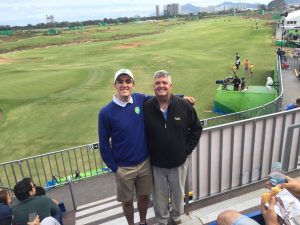Syngenta Welcomes Back Golf – TurfNet’s 2016 Olympic Golf Blog
The Professional Development Committee continues its ongoing series featuring TOCA Gardner award winners.
Syngenta Welcomes Back Golf – TurfNet’s 2016 Olympic Golf Blog
Gardner Award Winner for New Media — Publishing
by Scott Covelli, TOCA professional development committee
We asked Jon Kiger, of TurfNet, the following questions:
Please briefly describe your winning project.
 Our Gardner Award winning project “Syngenta Welcomes Back Golf” was a multimedia blog covering the return of the sport of golf to the Olympics after over 100 years. The blog included written posts, photos, podcasts and videos. We wanted to cover the history of golf in the Olympics, the current state of the golf market in Brazil (from both the player and superintendent perspective), the design, building and maintenance of the course, and of course the competition for Men’s and Women’s medals.
Our Gardner Award winning project “Syngenta Welcomes Back Golf” was a multimedia blog covering the return of the sport of golf to the Olympics after over 100 years. The blog included written posts, photos, podcasts and videos. We wanted to cover the history of golf in the Olympics, the current state of the golf market in Brazil (from both the player and superintendent perspective), the design, building and maintenance of the course, and of course the competition for Men’s and Women’s medals.
What were your main objectives in developing this project?
It was such a multi-faceted project that we wanted it to take the form of a documentary series more than a traditional written blog with photos. I believe we succeeded in that regard.
We wanted to put golf’s return to the Olympics in the proper historical perspective by looking back at the last time golf was an Olympic sport in 1904. We traveled to St. Louis and filmed a video at Glen Echo Country Club with longtime TurfNet member Joe Wachter.
Golf is taken for granted in the US, but has very little participation and history in Brazil so we wanted to look at as many aspects of the game as possible in the context of current day Brazil. Since this was being produced at TurfNet we knew it had to include the basics of course design, maintenance and volunteer tournament preparation. We were likely the only turf media on the ground in Rio, so we wanted to present enough information that the golf industry back home would want to know while watching the competition.
What influenced your approach?
I wasn’t sure exactly what I would cover once I got to Rio, so we were careful to create enough background coverage in advance of my arrival that the blog put golf in Brazil and the Olympics in the proper context.
We did this primarily through the Glen Echo Country Club video mentioned above and through podcasts on the competitors (Golfweek’s Alex Micelli), the architecture of the course (Brad Klein), and our interview with TurfNet member and Brazil native Rick Holanda. Rick described life as a superintendent in a country with so few golf courses.
We were in Rio for several days before the start of the Olympic golf competition. I was always on the lookout for interesting stories to tell about the Games in general or about golf in particular. At the field hockey/rugby venue, they had an introduction to golf demonstration area using oversized kids clubs. I took photos of the area and interviewed a newcomer to the game.
My son David was working hospitality for NBC and arrived a week before the opening ceremonies. The only venue they were allowed to see up close, as part of their security briefing/orientation, was the Olympic Golf Course. He took several photos of the advance preparation and we presented these exclusively on TurfNet.
I made contact with two Olympic Golf Course maintenance volunteers from Ireland (Eamonn McCarthy and Damien Colement) and met up with them in Rio. We did interviews with them in advance of their arrival in Rio and followed up with them about their experiences once there.
We wanted to cover as many aspects of golf’s return to the Olympics as possible so that anyone visiting the blog could learn the whole story of this historic event in our industry.
Please tell us what you think stood out in your winning entry.
So many things stand out about this project but first and foremost it was our sponsor Syngenta’s vision for the concept of the blog. Without their interest in having TurfNet cover Olympic Golf for the industry, I would have been just another spectator at the event. I’m not sure they or we understood all that would go into producing it or the special content that would result. I took advantage of every opportunity to report on golf’s return to the Olympics. It was the most intense yet satisfying project in my 30+ year career.
From a logistics standpoint, WIFI and internet weren’t available to me during the day so it very much felt like an “old school/pre-cell phone” project. I would leave early in the day, spend all day at the golf course collecting material, write it back at my cousin’s house, and file everything with TurfNet’s Peter McCormick before the end of the day. Peter would format this new material for the blog and have it ready for our visitors to TurfNet each morning. The 2016 TOCA Plant Health Writer of the Year John Reitman also helped with many of the volunteer interviews and strategizing on our approach to covering an event with so many different aspects. It was a true team effort – our own decathlon if you will.
I did not have a confirmed interview with course superintendent Neil Cleverly before my arrival in Rio. When I met him and arranged an interview I was careful to read his previous interviews so as not to repeat anything already covered. Rather than discussing the design, environmental concerns, turf type, etc… I asked him about the emotional aspect of finally having the golf competition onsite and what that meant to him and his crew. Neil later commented to me that he very much appreciated that approach and capturing the moment as it unfolded in Rio.
This was my third Olympics (Atlanta 1996 and London 2012 were the others) and it was great to see Rio in the world spotlight. My mother was born in Rio and by extension my sons and I also have Brazilian citizenship. Many of her cousins and their families reside there. It was nice to meet up with (and in some cases stay) them. It was also a family affair since my son David (studying Hospitality at Cornell University at the time) was there as a VIP host for NBC. He has been with me over the years for a variety of TurfNet projects and we were together for the first day of the men’s golf competition. The photo of the two of us at the 18th green is one I will cherish forever.
I want to thank Syngenta again for the support of this Gardner Award-winning project, everyone at TurfNet for helping it come together, and all the people in Brazil and elsewhere who volunteered their time and thoughts for our content in whatever form it took.
Postscript: Much has been written about the current state of many of the Olympic venues in Rio. The Olympic Golf Course is one of the only venues that is still operating on a daily basis as planned. Many aspects of life, politics, and the economy there still need to be resolved, but for three weeks in 2016 Rio showed the world the beauty and potential of one of the world’s foremost cities. I am humbled to know that TurfNet’s coverage of golf at the Olympics played a small part in documenting this historic return of golf to the Olympic games.

